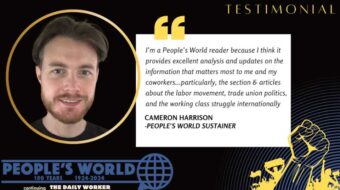NEW YORK — In an amazing bounce- back from the frustrating Nov. 2 electoral defeat, labor leaders, academics and rank-and- filers turned out en masse here to discuss and debate “Labor at the Crossroads: Competing Visions, Alternative Strategies, and the Future of the U.S. Labor Movement.” The 500 conferees were brought together Dec. 2-3 by the Queens College Labor Resource Center. They could all agree on one thing: in the face of the most vicious corporate assault in recent memory, this nation’s organized labor movement has to fortify itself with major structural and ideological upgrades in order to successfully fight to defend the working class.
Passionate expressions of strong opinions by labor leaders and activists were tempered with civility, perhaps based on recognition of the critical need for unity.
“We begin this debate in the open, in full public view,” said Brian McLaughlin, president of the New York City Central Labor Council, setting the tone. “Bring today’s discussion from union hall to union hall so our members can participate,” he urged. “We must look to our members for every challenge we face.” Then he dramatically ripped apart a Wal-Mart sign he had brought along for the purpose.
Bruce Raynor, president of UNITE HERE, the newly merged union of hotel, restaurant, clothing and textile workers, told the conferees he didn’t have all the answers, but he argued, through his union’s experience with industrial laundry workers, that it is necessary for each organization to take responsibility for a whole industry.
UNITE HERE, along with the Service Employees (SEIU), Laborers and Carpenters unions, earlier this year formed the New Unity Partnership. NUP has issued a controversial program for a radical restructuring of the AFL-CIO. It advocates consolidation of the federation’s roughly 60 unions into 20 large unions with defined industrial concentrations.
Five years ago, when UNITE made a decision to focus on industrial laundries, Raynor said, the union had only 10,000 laundry members with “low wages and lousy conditions.” The goals the union set were “wages people could live on, a defined-benefit pension plan, health care for the workers’ children,” and, he added ironically, “the communist notion of a few paid sick days.” The union has now achieved those goals for 97 percent of its represented workers, Raynor noted proudly, as a result of having organized 40,000 laundry workers, or 25 percent of the industry.
Gerry Hudson, SEIU’s executive vice-president, agreed with Raynor, adding, “For today’s unions, size matters in taking on globetrotting predatory corporations. It doesn’t work to have 60 different multisector unions.” SEIU has proposed designation of “lead” unions in each industry, with 50 percent of their resources going to organizing. Hudson also advocated developing unions in sectors where there presently are none and in non-union regions like the South. He also called for building global alliances of unions in the same industries around the world.
Taking a different tack, Larry Cohen, executive vice president of the Communication Workers, emphasized the role of shop stewards. CWA has 25,000 stewards. Cohen circulated his 10-point proposal for change, which focused on getting members into action. “If anyone thinks we’ll achieve collective bargaining rights based on restructuring rather than mobilization, they’re kidding themselves,” he said. Cohen, a founder of Jobs with Justice, challenged other unions to fulfill their commitments to mobilize and educate their memberships in support of the Employee Free Choice Act.
From the floor, former ConEd senior electrical technician Jerry Waters highlighted the concerns of small unions like the 50,000-member Utility Workers, of which he is national vice president. The UWUA vigorously fought deregulation in 1996, he said, while other unions in the utility field were passive. “How do I fit in?” he asked, unwilling to let that fight fall by the wayside in a merger.
“I like the debate and the idea of debate,” Waters told the World during a break in the conference. Waters was thinking about how to get the discussion onto the shop floor. “Stewards are our first line of defense,” he said. “We have to get back to the workers and talk about it. It’s their organization.”
The author can be reached at rwood@pww.org.











Comments